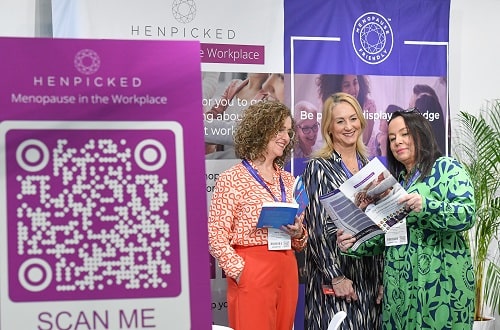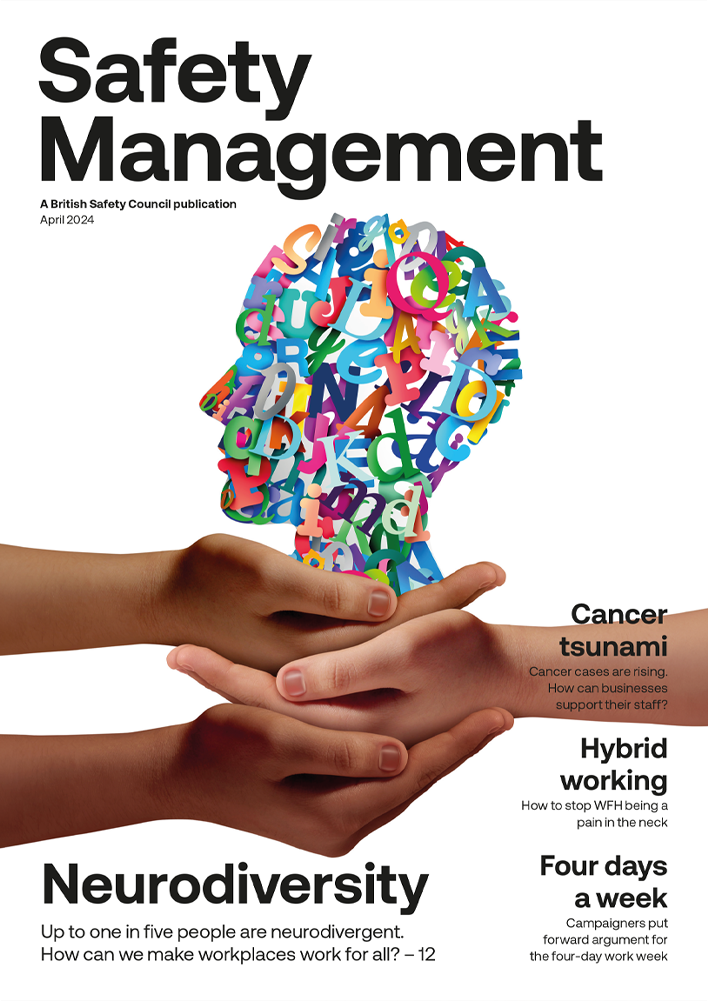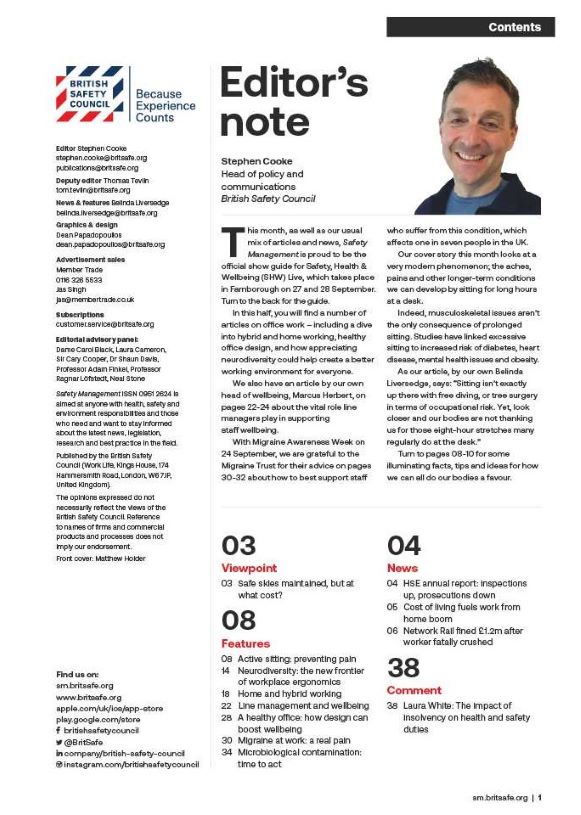The growth in home working can potentially boost worker wellbeing through steps like the removal of the daily commute, but employers need to ensure it doesn’t result in unwanted problems, like a failure to spot the signs of stress in their remote teams.
Features
Home and hybrid working post-pandemic: getting it right
There cannot be a single person across the globe who hasn’t felt their world turned upside down with the advent of the coronavirus pandemic in March 2020. The enforced restrictions took away choice for many around personal connections and leisure options, and certainly impacted on people’s physical and mental health and wellbeing.
In terms of our ways of working there was an initial rapid adaptation which saw many of us shifting to working from home, being furloughed, or adapting to our place of work as a ‘key worker’ with new strict control measures and much less interaction with colleagues. All of this brought stress and uncertainty, and no one was sure how long the situation would last.
 Employers need to do more to support the wellbeing and good working conditions of the entire workforce – whether they be site-based, home-based or hybrid workers. Photograph: iStock
Employers need to do more to support the wellbeing and good working conditions of the entire workforce – whether they be site-based, home-based or hybrid workers. Photograph: iStock
Now, more than two years later, we are left with a legacy of that adaptation with some measures still prevalent (such as mask wearing). However, possibly the most significant shift has been the widespread adoption of home and hybrid working in sectors and workplaces which had traditionally felt this was not appropriate or effective as a means of working.
Maybe the last point has been the most pertinent in shifting attitudes – widespread experience suggests that home working has actually boosted productivity, leading to many employers being keen to newly adopt or expand the use of this way of working. (‘More employers reporting increased productivity benefits from home working compared to last summer, new CIPD research finds’)
A new normal?
Although we may currently feel a status quo has been reached, arguably we are still in a state of transition and adaptation as we learn to live with the ongoing prevalence of coronavirus and other viral threats. It would appear that we have not yet reached an ‘equilibrium’ in our adapted ways of working.
Employers continue to navigate the options, watching closely to evaluate the effectiveness of the work practices in relation to productivity and cost savings. But the question is, has such a keen eye been kept on the health, safety and long-term wellbeing of employees in this evaluation?
Benefits of home working
Wellbeing professionals seem pretty much universally pleased with the benefits for worker wellbeing that have arisen from the shift to increased home working. Employers have faced increased calls and pressure to allow employees to work from home some or all of the time (where possible and appropriate), and home and hybrid workers have been encouraged by their employers and wellbeing experts alike to reap the benefits of home working by making positive health choices.
The key benefits for wellbeing are around the opportunity to achieve an improved work–life balance – for example, by freeing up time from often stressful commutes to re-engage with family commitments, leisure choices or hobbies.
Along with reducing the ‘stress’ of juggling commuting with work and life commitments, home workers also often benefit from a more flexible approach to working hours. Generally, working from home will not necessarily be restricted to the typical ‘nine to five’ and individuals can choose working hours across a wider portion of the day to fit with other commitments or preferences.
 Clare Forshaw: "Along with reducing the ‘stress’ of juggling commuting with work and life commitments, home workers also often benefit from a more flexible approach to working hours."
Clare Forshaw: "Along with reducing the ‘stress’ of juggling commuting with work and life commitments, home workers also often benefit from a more flexible approach to working hours."
Employers have also realised there are various business benefits – such as financial savings from the removal or reduction of fixed office space and the opportunity to recruit talent from a wider geographical pool by removing the need for staff to be physically present at a particular location. This also presents the opportunity to boost diversity among the workforce – for example, by allowing people to take up roles they were previously precluded from, due to factors like difficulties travelling to a workplace or having their needs accommodated in a traditional work environment.
However, although this will certainly help employers to boost equality, diversity and inclusion at work, there is a question about how inclusive a disparate workforce is if opportunities to physically meet, collaborate or build relationships are becoming rare.
Psychosocial needs and workplace wellbeing
The International Labour Organization states that ‘Workplace Wellbeing’ relates to all aspects of working life – from the quality and safety of the physical environment, to how workers feel about their work, their working environment, the climate at work and how work is organised.
The McKinsey consultancy firm, meanwhile, defines workplace wellbeing as an issue that explores fostering mind, body and sense of purpose in individuals, teams and organisations for a more resilient workforce and improved wellbeing.
Most of the definitions of workplace wellbeing from experts in the field also highlight the value of work in bringing people together to deliver to a common purpose. This opportunity to share a sense of belonging through work has proven to be a key driver for improved wellbeing.
 Home workers may experience loneliness or a lack of support due to poor contact with managers and colleagues. Photograph: iStock
Home workers may experience loneliness or a lack of support due to poor contact with managers and colleagues. Photograph: iStock
This topic has been explored in previous research and evaluation of the benefits of work for employee health. Waddell and Burton (2006) reported that work meets important psychosocial needs in societies where employment is the norm and is central to individual identity, social roles and social status.
Building on this, Dame Carol Black’s report, Working for a Healthier Tomorrow (2008), noted that work is a key determinant of self-worth, family esteem, identity and standing within the community. She also highlighted that work provides material progress and a means of social participation and fulfilment.
However, employers now face a significant challenge in supporting the wellbeing of staff, particularly if all or a large proportion of the workforce is based at home for all or some of the time. This can make it difficult to establish practices that support wellbeing, through a positive working culture and creating a sense of communal belonging and purpose through work which has been shown to support wellbeing.
Isolation and home working
The switch to home working has clearly brought wellbeing and other benefits for many employers and employees alike – such as the potential for an improved work–life balance. However, an employer’s risk assessment for home and hybrid working needs to identify and explore all the potential implications for workers’ health, safety and wellbeing.
A lot has been written about the impact the pandemic lockdown had on people’s mental health, with problems arising from challenges like feelings of isolation and a lack of connectivity with family, friends and the community.
It is therefore essential that employers consider the same potential impact on home workers’ mental wellbeing due to the lack of connection with work colleagues. For example, some home workers may experience loneliness or a lack of support due to poor contact with managers and colleagues, which could bring on pressure resulting in stress. Also, some may find it difficult to manage their time and work tasks, creating further pressure.
Employers also need to think about how they will meet their legal duty to manage work pressure and workload when people work from home. There may be difficulties in monitoring people’s working hours to ensure they are not working excessively and in spotting the early signs of stress and poor mental health among home workers.
Health and wellbeing inequity
Employers also need to be aware that allowing some staff to work from home could potentially create a two-tiered workplace wellbeing system.
During the pandemic lockdowns a lot of the mental and physical wellbeing effort and support provided by employers was geared at those working at home. Meanwhile, those attending physical work sites were often primarily bombarded with information and advice about Covid risk assessments and infection controls at work. Also, the particular stresses and concerns of those attending the workplace – such as fear of infection when using public transport and potentially passing the virus onto vulnerable family members – were somewhat disregarded.
Going forwards there is a danger that lauding and promoting the benefits and opportunities afforded by home working can only continue to divide workforces into those that can and those that cannot. This could create feelings of unfairness and resentment among those unable to work from home that could affect their motivation, loyalty and even their mental wellbeing.
What about traditional health and safety performance?
There has been much anecdotal evidence of the increase in near misses, accidents and safety incidents during and emerging from the pandemic. This is now starting to be translated in the statistics collected by companies and the Health and Safety Executive.
We know that traditional workplace health and safety risks remain. As a result, employers need to re-engage with the workforce to remind them of the vital importance of maintaining the correct behaviours and attitudes towards risk controls to ensure that everyone’s health and safety continues to be protected. This could mean revisiting and reinvigorating risk controls – for example, by reviewing risk assessments and providing refresher training.
Working at home can pose certain risks that may not be visible or obvious to managers who were previously only responsible for health and safety in the physical workplace. These include stress from a lack of manager or colleague support and a temptation to work longer hours, and health risks from the physical set-up of home workstations. Therefore, employers need to think about new and effective ways of identifying, evaluating and managing risks to the health and safety of home and remote workers. This may require greater and improved communication between managers and home workers and ways of undertaking remote risk assessments.
Driving a new culture
New ways of working in the modern world mean that employers, managers – and the organisation’s health and safety, occupational health and HR professionals – need to recognise the challenges these could pose to health, safety and wellbeing and adapt their approaches accordingly.
 Employers need to explore innovative ways to understand employees’ wellbeing needs and obtain employee feedback about the approaches that best support them. Photograph: iStock
Employers need to explore innovative ways to understand employees’ wellbeing needs and obtain employee feedback about the approaches that best support them. Photograph: iStock
A first step is leaders, as described above, taking ownership to ensure new, emerging and existing risks to worker health and safety are being properly assessed and controlled. Leaders need to respond to changes like the growth in home working by providing appropriate support for home workers’ mental wellbeing. However, leaders also need to consider if traditional, long-standing risks associated with the physical workplace are still being properly addressed – such as hazardous substances, work at height and musculoskeletal hazards.
The changes to the world of work arising from the pandemic have also changed the expectations many workers have about the quality of their working conditions and work arrangements. Satisfaction, reward and recognition – and other various working terms and conditions that support wellbeing – are becoming more important to workers. As a result, employers need to do more to support the wellbeing and good working conditions of the entire workforce – whether they be site-based, home-based or hybrid workers.
In summary
New ways of working, like home working, have created opportunities for better supporting and improving worker health, safety and wellbeing but also present a number of new challenges.
For employers, it is increasingly important to maintain good contact with workers in a variety of settings – including the home – and to ensure that workers’ psychosocial needs are being met. Employers need to explore innovative ways to understand employees’ wellbeing needs and obtain employee feedback about the approaches that best support their wellbeing across differing physical and virtual environments.
Risk assessment will remain important, but employers must recognise the new risks that are arising and be able to judge and respond to these swiftly and appropriately across the new work profile we have created.
Clare Forshaw is an occupational health and hygiene professional at Park Health & Safety. She previously worked for HSE for 20 years. Contact her at: [email protected]
parkhs.co.uk
Clare Forshaw will be speaking at the SHW Live exhibition in Farnborough, Hampshire, on 28–29 September, on ‘Post-pandemic working and the challenges to health and wellbeing’. See: safetyhealthwellbeing.live
FEATURES

Why line managers play a vital role in workplace wellbeing
By Marcus Herbert, British Safety Council on 03 September 2023
The behaviours of line managers can have a positive or negative impact on employee health, wellbeing and engagement, so it’s vital managers get staff feedback on whether their management style is supportive or negative, and have regular check-ins so workers can raise concerns about their wellbeing.

Watercooler Event to hone in on eight trends in employee health and wellbeing
By Claire Farrow, Make a Difference Events & Media on 15 April 2024
The free-to-attend Water Cooler Event at ExCeL London on 23–24 April will see more than 6,000 workplace experts coming together to explore the latest thinking, solutions and best practice for supporting and boosting employee wellbeing, diversity and workplace culture.

Sedentary working and how to combat the ‘sitting disease’
By Gavin Bradley, Active Working on 05 April 2024
Prolonged and excessive sitting poses a major risk to our health, but the Get Britain Standing campaign and On Your Feet Britain Day on 25 April are a great way of encouraging workers to sit less and move more.



